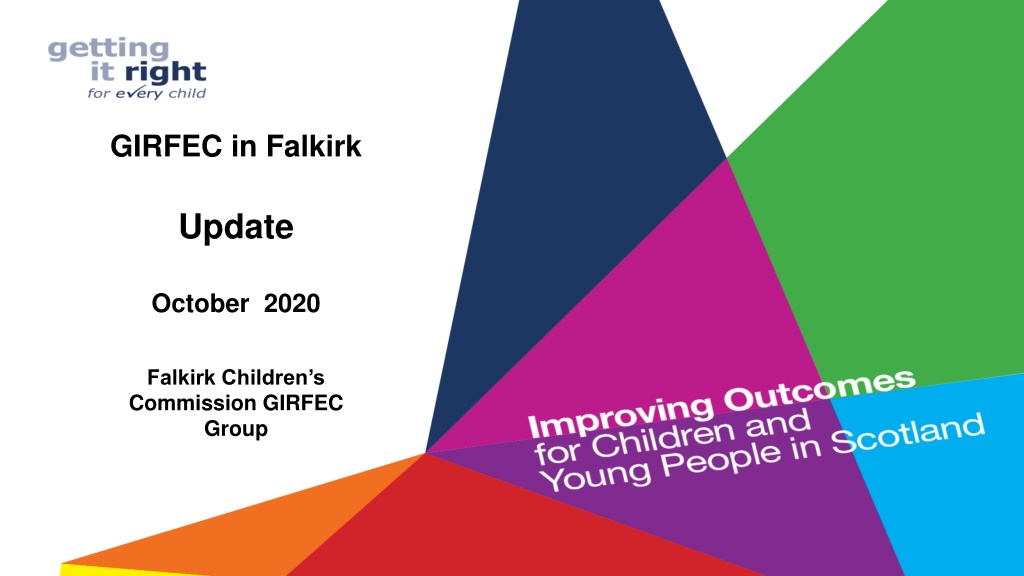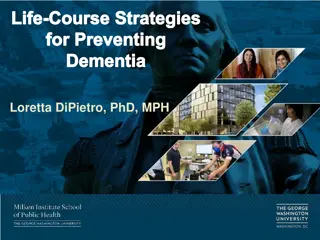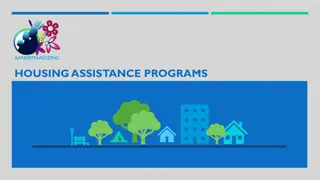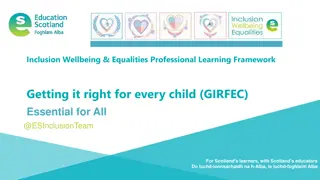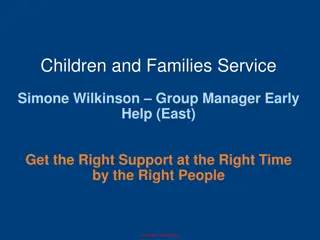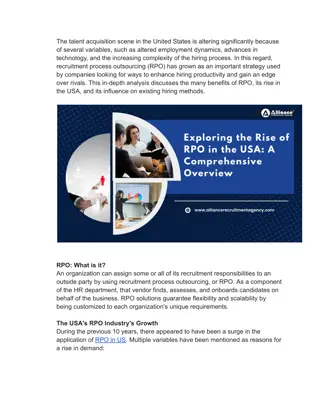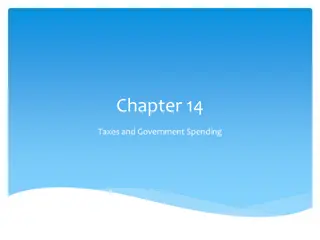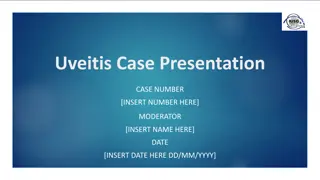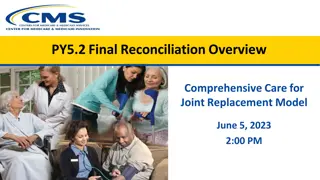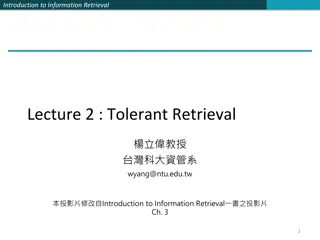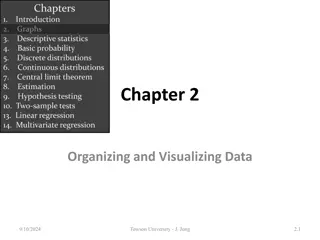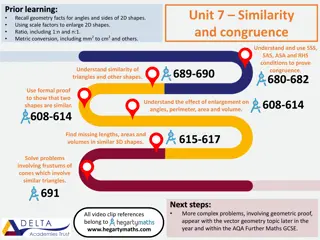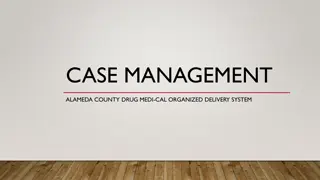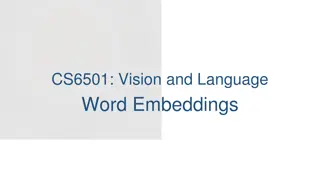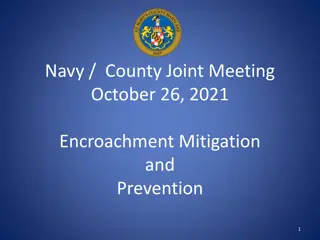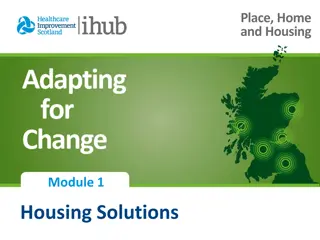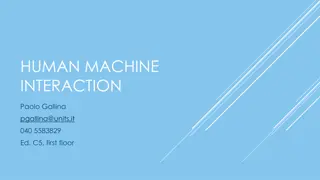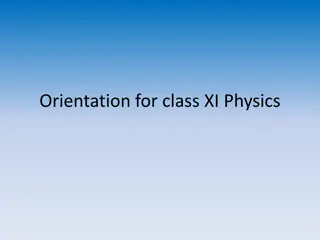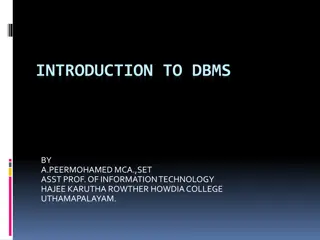Understanding GIRFEC in Falkirk: A Comprehensive Overview
GIRFEC (Getting It Right For Every Child) is a national children's rights-based approach aimed at improving outcomes from early intervention to child protection. It involves embedding culture, systems, and practice changes to ensure children receive the help they need when they need it. Every child up to 18 (and in some cases up to 25) is covered by GIRFEC, with all services working with children and families responsible for its implementation. GIRFEC emphasizes early intervention to address needs and involves children, young people, and families in decision-making processes. The concept serves as a "golden thread," bringing together various policies and frameworks to enhance the well-being and protection of children.
Download Presentation

Please find below an Image/Link to download the presentation.
The content on the website is provided AS IS for your information and personal use only. It may not be sold, licensed, or shared on other websites without obtaining consent from the author. Download presentation by click this link. If you encounter any issues during the download, it is possible that the publisher has removed the file from their server.
E N D
Presentation Transcript
GIRFEC in Falkirk Update October 2020 Falkirk Children s Commission GIRFEC Group
CONTENTS GIRFEC Context Information Sharing Your role as a practitioner Named person Lead professional The Child s Plan 2
GIRFEC in Falkirk & COVID - 19 The rights of children have not changed during COVID - 19, and nor do professional roles and responsibilities in relation to Getting It Right For Every Child. We are likely to see a rise in wellbeing and child protection concerns due to the impacts of the pandemic on families and wider society. COVID 19 should not stop you doing what you are required to do to ensure wellbeing and protection needs are identified and responded to appropriately. You can find more information on GIRFEC Child s Plan and Child Protection pages on the GIRFEC Falkirk practitioner pages. Child(ren) is used throughout and should be taken to mean infant, child, young person and young adult up to the age of 18 and in some circumstances up to the age of 25. 2
What is GIRFEC? What is GIRFEC? It is the national children s rights based approach to improving outcomes for our children from early intervention to child protection. What does it aim to do? Embed culture, systems and practice change to bring together and coordinate services so that children get the help they need when they need it. Who is it for? Every child up to the age of 18 and in some circumstances up to the age of 25. All services working with children and their families, including adult services, are responsible for implementing GIRFEC Where has it come from? GIRFEC was introduced by the Government in 2006 as it was widely recognised that services needed to work together and that children and parents needed one clear point of contact to ensure that the right help is offered at the right time. What does it involve? It is a way of working that builds on strengths and capacity of children and families to improve wellbeing. It promotes a rights based approach that recognises the importance of children, young people and families involvement in decision making about the help they need and how it should be organised and delivered. It is aimed at tackling needs early to avoid bigger problems or concerns developing. 3
GIRFEC = THE GOLDEN THREAD GIRFEC brings all of our policy together GIRFEC Scottish Government National Performance Framework Children & YP Scotland Act 2014 National & Local Child Protection Guidance Delivering Excellence and Equity in Scottish Education Additional Support Needs Whole Systems Approach (youth Justice) Early Years Framework Getting Our Priorities Right Mental Health Task Force Closing the Attainment Gap (PEF) National Improvement Framework Curriculum for Excellence Developing the Young Workforce (DYW) Corporate Parenting Family Support Realising the ambition Child Protection Guidance Better Health, Better Care UNITED NATIONS CONVENTION ON THE RIGHTS OF THE CHILD (UNCRC) 4
GIRFEC Core Components & Values and Principles Focused on improving outcomes for the child and their family Based on an understanding of the wellbeing of a child in their current situation and on tackling needs early Provides a clearly identified point of contact via the named person Requires joined-up working, proportionate assessment and planning Supports informed choice, respects confidentiality and proportionate sharing of relevant and necessary information Identifies a lead professional to coordinate one child s plan when services need to work together 6
INFORMATION SHARING
Information Sharing Data protection law is not a barrier to proportionate information sharing with other agencies/services where the child and their family are in agreement with this, or where there are real concerns about a child s wellbeing. Proportionate means sharing only what is absolutely necessary with the relevant person/s at the appropriate time. Proportionate sharing of relevant and necessary information helps promote, support and safeguard the wellbeing of a child can help them access supports/ services. Information sharing needs to be transparent, except in rare circumstances where this would pose a risk to the wellbeing of the child. So we need to explain to people what information we are sharing about them, with whom and why. In almost all cases, the child (and, where appropriate, their family) should have an informed choice as to whether information about them is shared with other agencies/services In most circumstances, children and, where appropriate, parents will be involved in decisions about sharing information with other agencies/services where this would be beneficial and appropriate. 8
Information Sharing The Information Commissioner (who oversees data protection law in the UK) recognises that there is a continuum from wellbeing concern to child protection concern. Sharing information early can prevent the move towards a child protection concern and, as long as proportionate, is lawful, even though the child or young person and their family disagree that information should be shared. Where there is a child protection concern, relevant information may be shared without consent immediately. Child protection processes can be found here. In all cases, it is important to record your reasons for sharing (or not sharing) information, including the views of the child or young person and their family. 9
Your role Named person Lead professional
Your role as a practitioner Work with Families. Engaging with children, young people and families around the GIRFEC key questions is central to the national practice model. Establishing trusting and open relationships between practitioners and families, where everyone s views are respected, underpins this engagement. Use the 6 Key Qs to assess wellbeing needs. The 6 key questions have been updated to include one about Children's Rights. The 6 Qs. should be used by practitioners as a prompt. See next slide. Also see appendices 1 and 2 for wellbeing prompts during the pandemic. The Child's Plan (the updated version of the Child s Plan Version 3/ Old IAF) has everything you need to assess and plan for children. Share information with named person/ other services Practitioners should be clear about what information sharing will be necessary, with whom and for what purpose. It might be necessary and appropriate to share information without agreement. If you share, you must be open and clear about information being shared and why, and record this. If you decide not to share specific information, you should record this stating the reason for not sharing. 11
Your role as a practitioner Remain responsible for wellbeing Passing on information doesn t mean passing on responsibility. When you raise a wellbeing/ child protection concern with another service, your support doesn t automatically stop. You need to ensure the child s needs are being met. If needs are not being met, you should escalate the concern through the TAC or using the escalation guidance, to ensure support is provided at the right time. (see the GIRFEC pathway for more detail) Carry out the agreed actions in the Child s Plan. Practitioners have responsibility to deliver their own agency s part of the child s plan Report Child Protection Concerns Immediately. Where there is a child protection concern, relevant information should be shared without consent immediately. Child Protection Processes can be found here 12
Your role Adult Services GIRFEC is the national multi-agency approach to improving outcomes for children and young people All practitioners working in adult services have a duty to follow the GIRFEC principles and approach, when working with adults who have children or caring responsibilities. Adult services should be familiar with the GIRFEC approach and understand their role in meeting children and young people s needs if they are working with parents and carers. The information in this update is relevant to all practitioners working in adult services. 13
GIRFEC 6 Key Questions When thinking about a child or young person s wellbeing, practitioners should ask themselves GIRFEC 6 key questions: What is getting in the way of this child s wellbeing? Do I have all the information I need to help this child? What can I do now to help this child? What can my agency do to help this child? What additional help, if any, may be needed from others? Are this child s human rights being met? If there are unmet needs, the Child's Plan should be used either a single service or TAC. When there are concerns about a child s wellbeing or safety Child Protection procedures must be followed. 14
The Named Person Every child and their family has a right to access support when they need it. This can be done via the named person, a clear point of contact that can offer help/ support to families when needed. For most children and young people the named person will not need to do anything more than they normally do in the course of their day to day job. This is because most children get all the help they need from their families and the universal services of health and education. A named person does not replace parents or carers who have a primary responsibility for bringing up their children. Children, young people and parents are not obliged to take the support or assistance offered by named persons. A named person is available to listen, take account of children s rights, their, and their families , views, advise and help a child and their parent(s), provide direct support or help them access other services. Is a point of contact for other services who have any concerns about a child s wellbeing. 15
Role of the Named Person Use the 6 key questions to identify wellbeing needs or address concerns. Carry out an holistic assessment of wellbeing to develop the child s plan Contribute to a child s plan and be a member of the Team Around the Child when there is more than one service involved Following the law and guidance on data protection, confidentiality and human rights, share information with other services to meet children s wellbeing needs When professionals, including the named person, are concerned that the child may be at risk of significant harm, they must use the Child Protection procedures to safeguard the child. 16
Who is a named person? Who the named person is depends on the age of a child. For children under 5/ before school starts Health Visitor or Family Nurse Partnership For Children over 5 or in school Head teacher/ Depute/ Pastoral Teacher The named person for Gypsy Traveller children, a child who is home educated, a young person age 16 18 and not in school is a key contact within Falkirk Council Children s Services. When children are Looked After and accommodated/ educated out with the local authority area, the named person is from the local authority area where they live/ go to school . For a young person who is serving a custodial sentence the named person is a representative from the Scottish Prison Service. 17
The Lead Professional Not every child needs to have a lead professional. When the child s plan would benefit from coordination across two or more services this will be led by a lead professional. The child or parent may express a preference for a particular practitioner, perhaps because of an existing relationship. Where practical, this person should be the lead professional. The lead professional will not do all the work with the child; neither do they replace other practitioners who have specific roles 18
Role of the Lead Professional The role of the lead professional is to: Help children, young people and families to participate fully in the assessment, making the plan, and make sure their views are heard. Make sure the TAC use the Child's Plan Be the main point of contact regarding the plan Make sure it is recorded accurately, understood by all, and shared with all relevant people involved Co-ordinate, monitor and review the agreed supports and actions in the plan Make sure transitions are planned for Ensure that the help and support agreed and recorded in the plan is provided and is improving outcomes for the child 19
Lead Professional Examples For children below school age the lead professional would usually be a Social Worker or health professional. For children who attend a mainstream school, but have some additional support either from Health, Education or Social Work the lead professional would usually be the Guidance Teacher. For Looked After children and children on the Child Protection Register the lead professional would usually be the Social Worker. 20
The Childs Plan A child s plan is written when support is needed from more than one service. The Child's Plan should be used to develop a joint assessment and plan which meets wellbeing needs, and plans for transitions as the child grows up. The plan should be jargon free and provided in a format that is easily read and understood. Children s rights should sit at the heart of the child s plan. The plan helps to structure and record information, identify needs and concerns, and then to plan how needs will be met. The plan will be created with the child and their family based on the assessed wellbeing needs. The Child s Plan will be actioned with the child and their family either as members of the team Around a Child or as members of the Child Protection core group. 22
Childs Plan Meeting - TAC A child s plan meeting should always have the child s rights and wellbeing needs at the centre. In Falkirk, child s plan meetings are known as Team Around the Child (TAC) Meetings. If a child is on the child protection register, the plan becomes a child protection plan and the meeting is known as a Core Group. The Team Around the Child is the group of people, including the child, family members and professionals, who will work together to support the child to meet any identified needs or concerns. 23
Childs Plan Within this multi-agency plan there will be a need to join up other planning processes such as; individual education or medical plans co-ordinated support plans compulsory measures of supervision self-directed support a child protection plan young carer s statement or a child s plan under the Looked After Children (Scotland) Regulations 2009 and Pathway Plans for care leavers. 24
What is in a Childs Plan? Each plan will be unique to the individual child however it would be expected that they should all contain: The reasons for the plan Who are the partners to the plan A summary of the child s wellbeing needs that are being addressed by the plan The desired outcomes and how it will be known that they have been achieved The views of the child and their parents Details of action to be taken and by whom and which service Timescales for action and for progress, including transitions that may be ahead Arrangements to review the plan Lead professional arrangements Use the Falkirk Child's Plan to write the plan. 25
GIRFEC National Practice Model
GIRFEC National Practice Model Has 3 parts: The Wellbeing Wheel; The Resilience Matrix; The My World Triangle The model should be used with the child and family throughout the child s plan in a cycle of observation, assessment, planning, support and review The wellbeing wheel helps us to understand and assess the initial needs. The My World Triangle helps assess how the child is growing and developing, what they need from the people who look after them, and the impact of their wider world, including their family, friends and community on their wellbeing needs. The Resilience Matrix helps to analyse risk and protective factors, the child s strengths and resilience; adversities and vulnerabilities Falkirk Child s Plan Guidance and documents can be found on the GIRFEC Falkirk Practitioner Pages 27
GIRFEC National Practice Model The National Practice Model is a key tool that provides a consistent way for practitioners to work with children, young people and their parents to understand and discuss wellbeing and the world of the child, in the context of their strengths, resilience, adversities, and vulnerabilities. More info on National Practice Model on Scottish Government web. 28
Wellbeing Wheel The wellbeing indicators are the starting point to assessing needs. They are a tool to help children, families, and the people working with them, discuss how a child is doing at a point in time and if there is a need for support. Each child is unique and there is no set level of wellbeing that children should achieve. Wellbeing is influenced by children s individual experiences and changing needs as they grow. Using the wellbeing wheel along with the GIRFEC 6 key questions will help identify any unmet needs, or start a discussion about any concerns. More information on Wellbeing on Scottish Government Web 26
Wellbeing Needs and Concerns Wellbeing needs or concerns may be a single issue, a single event, multiple or cumulative events. Wellbeing needs should be assessed with the child, and, where appropriate, their parents/carers family to develop a plan of action that; describes what s working well/ what s getting in the way of a child s wellbeing needs being met Identifies, strengths, priorities and solutions identifies expected outcomes. Remember, risks and needs are 2 sides of the same coin. Risks emerge from unmet needs. Falkirk Child s Plan Guidance and documents can be found on the GIRFEC Falkirk Practitioner Pages 30
The My World Triangle The My World Triangle assessmenttool has been designed to help practitioner s working in partnership with children, young people, parents and carers to think about the whole person and their circumstances. A chronology or list of significant events should be used to help understand assessment information. The three sides of the triangle around the child represent their world. An multi agency plan should address all these areas of life that are relevant to the child so that a complete picture is formed. This should include strengths. An integrated plan should be aimed at supporting and developing these strengths, as well as being concerned with overcoming difficulties or filling gaps. Falkirk Child s Plan Guidance and documents can be found on the GIRFEC Falkirk Practitioner Pages 31
29 32
The Resilience Matrix When children or young people have complex needs or concerns, or where safety is in doubt, practitioners may use the Resilience Matrix to help them to analyse the information they have about the child s circumstances. Using the matrix to help understand both the strengths and vulnerabilities can help practitioners think through the information gathered when looking at the My World Triangle. Please see appendix 3 for a worked example of the resilience matrix. For more information see: Falkirk Child s Plan Guidance and documents can be found on the GIRFEC Falkirk Practitioner Pages The Scottish Government Resilience Matrix Practice Briefing and the 2012 National Risk Framework 33
Transforming lives through learning Document title 31
The Resilience Matrix When looking at adversity, consideration will be given to life events or circumstances posing a threat to wellbeing and development, such as loss, abuse, neglect, poverty, poor or unsuitable housing. When looking at vulnerability, consideration will be given to characteristics of the child, their family circle and wider community which might threaten or challenge wellbeing, such as disability, very poor health and prejudice in the community and lack of, or poor attachment. In turning to strengths, a protective environment may include factors that act as a buffer to the negative effects of adverse experience, for example, in the home, the wider family network and friends, the services that help, the school and in the wider community. When looking at resilience, consideration is given to characteristics of the child which helps them develop under difficult circumstances, such as having a sense of belonging within a secure loving family, good self esteem, an outgoing temperament or nature and developing problem solving skills. 35
A short film on how to use the resilience matrix. Produced by the West of Scotland Child Protection Consortium, written and narrated by Sally Wassell Click the image of the children to play the film
GIRFEC & CORONAVIRUS
Keep listening, talking and reviewing needs & plans Continue to have conversations with the children and families you are supporting. Remember that any wellbeing concerns should continue to be shared with the child s named person. Needs may have changed during lockdown. Check in with children and families. Children with multi agency child s plans should still be being contacted/ seen as per Scottish Government guidance on vulnerable children. Pick up the phone and talk to colleagues. Continue to discuss concerns, share information, and agree how supports will be provided and by who during COVID. 38
Keep listening, talking and reviewing needs & plans Remember that a formal meeting is not always required to ensure a child gets the support they need. Support can be arranged out with Team Around the Child meetings. If virtual meetings are being arranged, please make sure; the views of children and young people are being listened to You find out children/ families preferred method of communications Meetings are planned when everyone can make it and in a way that everyone can access the technology. Do not work or make decisions in isolation: silo working benefits no-one least of all our vulnerable children. 39
APPENDICES 1. Questions for children and young people during the pandemic 2. Wellbeing (SHANARRI) prompts during the pandemic 40
Appendix 1 - Wellbeing: Things you might want to ask children/ YP/ families during COVID-19 Lockdown Do you have any concerns about your wellbeing at the moment. For example, do you have enough food, somewhere to sleep, people to look after you? Do you feel safe just now? (are there any risks at home from their own behaviour; alcohol, substances, online or from others; alcohol, substance use, domestic abuse, parent/ carers health?) Coronavirus and lockdown is a very stressful thing. Sometimes people can act and behave a bit differently than normal and we are all cooped-up, is there anything happening in your family/life that is making you afraid or causing you to worry that you might need help with? Before coronavirus sometimes you/ your family have needed some extra support or others have been worried about you. Is there anything you want to talk about in terms of how things are at the moment?" Adapted from NHS Forth Valley CAMHS COVID Guidance 2020. 41
Appendix 2 Wellbeing SHANARRI Prompts Do you feel safe at home if you are in alone? Do you have emergency contact details close by if you need to call anyone? You are probably spending more time online than you usually would, are you keeping yourself safe online and thinking about the consequences? Do you know who to ask for help if you are worried or scared? Healthy You may be at home on your own during the day, are you making positive choices with meals and snacks? It s a stressful and worrying time for a lot of us and this can take it s toll on our mental health, do you know how to deal with this or who to speak to? It s important to have routines, have you already made one up or have you thought about creating one? Achieving Are you spending some time each day looking at school work to help you learn and improve? What do you like best/worst about online learning? Do you know how to ask your teachers for help through online learning? You have a lot more free time than usual, it s important to be involved in activities are you trying to l earn or improve a new skill or a new hobby? Nurtured It s a difficult time for everyone is some checking in on how you are feeling? Are you finding ways to keep in touch with family who you can t go and see as you normally would? Are you speaking to your friends about how you are feeling? Safe 42
Appendix 2 Continued Wellbeing - SHANARRI Prompts Active Respected Do you feel you re listened to and people are taking your views on board? Are you respecting all in terms of your contact with other people, thinking about social distancing? It is a stressful time for everyone, so emotions can be high at times. Are you respecting all in regards of your communication with others (people at home and friends) Do you feel like your local community are respecting all by following the governments guidelines? Responsible You might have added responsibilities at home such as looking after siblings, cooking for yourself, are you coping with these? Are you thinking about the consequences by making sure you are being responsible with social distancing? Are you thinking about the consequences by washing your hands regularly? A lot of responsibility now falls on you to get on with some school work, are you being sensible about this? Included Are you able to keep in touch with your friendship group? It s important to get involved! Are you finding ways to keep in touch with family who you can t go and see as you normally would? It s important to remain physically active at this time, how are you ensuring that you are getting some exercise? You took part in after school/ sports/ dancing during normal life, are you able to keep up with any of these activities at all? Adapted from Aberdeenshire GIRFEC COVID-19 HT Guidance2020 43
